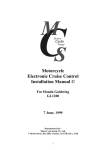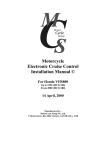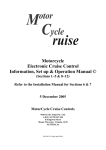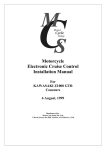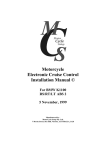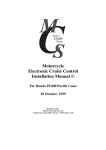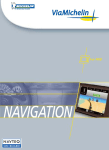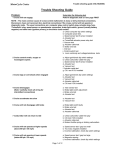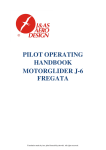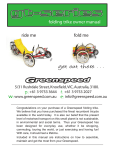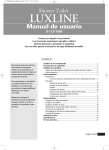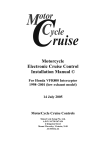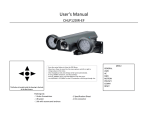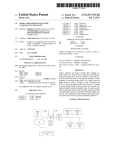Download Motorcycle Electronic Cruise Control Installation Manual
Transcript
Motorcycle Electronic Cruise Control Installation Manual For DUCATI ST2 24 July, 2000 Manufactured by MotorCycle Setup Pty. Ltd. 7 Moritz Street, Box Hill, Victoria, AUSTRALIA, 3128 Ducati ST2 -all models © MotorCycle Setup Pty. Ltd. Electronic Cruise Control Installation Manual © To suit Ducati ST2 Your electronic cruise control has been adapted from an Australian designed, automotive cruise control specifically to suit your motorcycle. Months of testing have resulted in changes to the electronic circuitry to deliver safe, reliable operation on the motorcycle models listed above. It is essential that you install the correct kit to your motorcycle and follow the installation instructions precisely so that electrical interference does not cause the unit to behave erratically or be rendered inoperative. WE STRONGLY RECOMMEND AGAINST FITTING OFF-THE-SHELF MOTOR CAR CRUISE CONTROLS TO ANY MOTORCYCLE! If, after reading these instructions, you feel you are not competent to install this kit, we strongly urge you to seek the assistance of one of our authorised dealers and installers. Please phone or email us to obtain the name of your nearest outlet. A list will also be available soon on our ‘web page’ http://www.netlink.net.au/mcsetup. WARNING: This cruise control is NOT fitted with a cruise control cutout switch on the clutch. Disengaging the clutch while the cruise control is engaged could over-rev the engine causing damage to the engine or produce a dangerous riding situation. DO NOT DISENGAGE THE CLUTCH WHILE USING THE CRUISE CONTROL UNLESS YOU HAVE ALSO PURCHASED AND INSTALLED THE OPTIONAL CLUTCH CUTOUT SWITCH. CONTENTS 1. INTRODUCTION 2. WARNINGS , CAUTIONS AND NOTES 3. TOOLS REQUIRED 4. PARTS LIST 5. OVERVIEW OF CRUISE CONTROL OPERATION 6. PREPARING THE BIKE FOR CRUISE CONTROL INSTALLATION 7. INSTALLATION 8. DIAGNOSTIC MODE OPERATION 9. M ANUAL ADJUSTMENTS TO THE BRAKE PEDAL AND FRONT BRAKE LEVER 10.OPERATING INSTRUCTIONS 11.SAFETY ISSUES & FEATURES 12. ROAD TEST AND ADJUS TMENTS 13. TROUBLE SHOOTING, TESTING & S ELF D IAGNOSTICS 14. RIDING TIPS 2 Ducati ST2 -all models © 1. INTRODUCTION Congratulations, you have purchased one of the most advanced cruise control systems in the world - and the first after- market electronic cruise control kit adapted to motorcycles. Your new cruise control has more operating features than many units costing much more. All functions are microprocessor controlled, which reduces the complexity of installation. Before installing your cruise control, take the time to read and understand each installation step in this manual. Several steps are dependent on others, so it is important know where and how each component is to be mounted before installation commences. Your kit has been designed for a specific motorcycle. Even if you have installed kits before, take note of where and how components should be installed - particularly the wiring harness layout and connections. 2. WARNINGS, CAUTIONS and NOTES This manual contains several cautions , warnings and notes, which are prominently displayed. The convention used is: A warning applies whenever injury could result from ignoring the warning; A caution applies whenever damage to the bike or cruise control could result from ignoring the caution; and A note applies where other aspects should be considered before any action to do with installation is undertaken. EXAMPLES: WARNING: Always ensure the bike is properly supported on the side or centre stand and cannot accidentally fall off either stand. CAUTION: Before drilling any holes, make sure there are no components that may be damaged on the other side of the surface being drilled. Double check for any wiring harness which might be easily damaged by a drill bit. NOTE: It is important to keep magnets as close as possible to the fixed sensor, but keep magnets way from hot surfaces such as brake disks, exhausts and catalytic converters. 3. • • • • • 4. TOOLS REQUIRED A tool kit containing appropriate spanners, allen keys and screwdrivers; Loctite ‘243 or 222’ or equivalent; A 1/4" or3/8" drive metric socket set with sizes down to 8mm is recommended. Flat file and a vice with soft jaws or a grinder or sand paper PARTS LIST Check that all components depicted in the parts list at the rear of this manual are included in the cruise control kit. Please phone (03) 9808 2804 or 0411 457 147 within Australia, international (61 3) 9808 2804 or fax (61 3) 9808 2445 for advice, if any parts are missing; 3 Ducati ST2 -all models © 5. OVERVIEW OF CRUISE CONTROL OPERATION The following diagrams show the basic assembly procedure and operating principles of the cruise control Cable Interface Unit (CIU). The actual entry points of cables and the direction of rotation may differ depending on the model of the motor cycle, but the principles involved remain the same. Specific assembly instructions are provided later within this manual. In order to improve the clarity of the diagrams, the multiple holes in the carburettor and throttle spools have been omitted, with only the actual hole used for the cable nipple being shown. 1st step. The actuator spool is installed in the CIU housing with the actuator cable. The actuator spool is rotated to fully extend the cable. Actuator cable CIU housing Actuator spool Bush 2nd step. The carburettor cable and spool are installed and the other end of the carburettor cable is attached to the carburettors. Roll pin in carburettor spool Carburettor spool Note the position of the roll pin. It is nearly contacting the end of the groove in the actuator spool. The free play in the carburettor cable must be adjusted so that the cable outer can be pulled out 2 ~ 3mm before the carburettors start to open. This ensures that the cruise control cannot prevent the carburettors returning to idle. If more free play is allowed the response of the cruise control is compromised. Carburettor cable 2 ~ 3 mm This adjustment of free play is usually performed after final assembly of the CIU is completed and the CIU is in its final location. This is because flexing the cable does effect the free play. It is shown at this stage in these diagrams to improve clarity. 4 Ducati ST2 -all models © After this adjustment is performed, the carburettor cable adjustment MUST NOT BE MOVED. All future adjustments of free play in the throttle must be performed on the throttle cable from the throttle grip. If incorrect free play in this cable is suspected due to inconsistent cruise operation or because of inconsistent idle speed, the adjusters on the throttle cable from the hand grip must be backed all the way off to give as much free play as possible. If this does not result in AT LEAST 5mm of free play in the throttle cable, the throttle cable must be removed from the hand grip or CIU before adjustment of the carburettor cable is attempted. This is crucial because the amount of free play in the throttle cable also effects the apparent free play in the carburettor cable. 3rd step The throttle cable and spool are installed. Note that the throttle spool and the actuator spool both have identical grooves in them. These grooves engage the roll pin in the carburettor spool (the centre spool). Throttle grip cable Throttle spool Normally the end cap and retaining nut would be installed at this point. These items are not shown in order to improve clarity. Normal throttle operation During normal operation of the throttle, the throttle cable is pulled by twisting the throttle grip. This pulls on the throttle spool and rotates it. The end of the groove contacts the roll pin in the carburettor spool, and the carburettor spool rotates, pulling the carburettor cable and opening the carburettors. Throttle grip is twisted pulling cable Roll pin in carburettor spool is pulled around by the end of the groove in the throttle spool Carburettor cable opens carburettors Actuator spool does not move Because the roll pin is free to move in the groove in the actuator spool, this spool does not move. This reduces friction in the throttle system and prevents any possibility of jamming due to cables buckling when being pushed. 5 Ducati ST2 -all models © Cruise operation During cruise operation the actuator cable pulls the actuator spool and rotates it. The end of the groove contacts the roll pin in the carburettor spool, rotating the spool and pulling the carburettor cable. Actuator cable is pulled by actuator Throttle spool does not move If the throttle grip is twisted enough for Carburettor cable opens carburettors the groove in the throttle spool to contact the roll pin, then the cruise control is over ridden by the rider. When the throttle is released, the cruise control will resume control, unless it has been disengaged by brake operation or if the motor cycle exceeds the current set speed by 150% such as during an overtaking manoeuvre. The cruise will also disengage if the speed drops to 75% of set speed such as when riding up hill. This is unlikely to occur on large capacity motorcycles. 6. PREPARING THE BIKE FOR CRUISE CONTROL INSTALLATION Remove the following items from the bike: • • • • the seat; the mirrors; the complete fairing; the LHS rear side cover. LUBRICATING THE THROTTLE GRIP – this is essential maintenance. • • • • • • Remove the two screws which secure the cable cover on the front of the throttle grip housing; Remove the two bolts which mount the throttle grip housing to the handle bar; Pull the two halves of the grip housing apart; Remove the cable nipple from the handgrip and the RHS handlebar weight. Slide the handgrip off the bar; Run 6 drops of light oil - eg sewing machine oil (not engine oil) down the throttle cable; Apply a thin film of engine oil or an oil/grease mixture to the handlebar and re- install the handgrip and housing. 6 Ducati ST2 -all models © 7. INSTALLATION The main components to be installed include the wiring loom, the cable interface unit, the vacuum actuator that controls the carburettor via the cable interface unit, the computer, the speed sensor and the switch. Installing components in the following order has been found to be the most efficient. 7.1 INSTALLING THE CRUISE CONTROL SWITCH • Remove the cap screws from the clutch master cylinder mounting clamp on the handlebar (LHS); • Remove the clamp bracket from the handlebar and use a file, grinder or sandpaper on a flat surface to remove material equivalent to about ½ the thickness of the switch mounting bracket from the bottom face of the clamp. • Insert the two cap screws into the clamp and through the switch bracket with the bracket on the bottom screw; Screw the cap screws into the master cylinder using a 5mm hex key and position the master cylinder ensuring that the switch bracket does not interfere with any other parts. Tighten the bottom cap screw, then the top one; • • 7.2 • • • Run the switch wire down the handlebar with the clutch hydraulic line, then backwards until it rests in front of the LHS fairing mount. The plug will be connected later. Cable tie the wire to the clutch line in several places using the small cable ties. INSTALLING THE COMPUTER Position the computer as shown in the photo with the connecting plug pointing forwards; Thread a cable tie through the ‘top’ tab on the computer and tie the computer tightly to the top frame rail as shown in the photo; Thread a cable tie through the lower tab on the computer, thread it around the lower frame rail and pull it tight. 7 Ducati ST2 -all models © 7.3 INSTALLING THE CABLE INTERFACE UNIT (CIU) NOTE: • • • • • • • • The following instructions involve working behind the radiator. Take care not to touch the radiator, as the cooling fins are very easily damaged. Back-off the cable adjuster at the throttle grip all the way; Disconnect the throttle cable at the carburettor end and remove it from the frame behind the head stem. Let it lie behind the radiator on the RHS of the bike; Run several drops of light oil (sewing machine oil) down the new carburettor cable (supplied) and install the adjuster at the cylindrical nipple end of the cable, to the carburettor bracket with one nut in front of the bracket and one nut behind. Position the adjuster so that it is screwed all the way into the bracket. DO NOT ATTACH THE NIPPLE TO THE CARBURETTOR SPINDLE YET; Allow the free end of the carburettor cable to hang over the outside of the RHS frame rail and run beside the radiator; Run the lock nut on the throttle cable to the top of the adjuster; Lay the actuator on the ground on the LHS of the bike and carefully draw the actuator cable through from the LHS of the bike immediately behind the radiator until it is well clear of the radiator on the RHS of the bike; Screw the CIU onto the adjuster on the actuator cable in the threaded hole in the bottom of the CIU, until the adjuster bottoms in the CIU. Back off until the flat on the cable end lines up with the lock screw. Gently tighten the lock screw onto the flat side of the threaded end of the cable. Attach the bracket mounting bracket to the CIU as shown in the photo at right using Loctite 222 on the bolts; 8 Ducati ST2 -all models © • Insert the ball nipple on the actuator cable into the actuator spool and locate the spool in the CIU with the semi-circular groove facing upwards. Rotate the spool anti-clockwise to fully extend the cable; • Insert the ball nipple on the carburettor cable into the threaded hole in the centre of the CIU body and screw the adjuster all the way in; • Locate the ball nipple in the marked hole in the spool with the roll pin in it and place the spool in the CIU so that the roll-pin engages in the groove in the actuator spool and the shoulder on it faces the actuator spool; • Insert the bolt with a flat washer under the head from beneath the CIU, then install the bush in the two spools in the CIU. Pull the free end of the carburettor cable (near the carburettors) to seat the roll pin and ensure the spools move freely; • Place the throttle cable retainer over the throttle cable adjuster. The retainer will be bent up so that it lies parallel to the cable later. Place the nipple on the throttle cable in the marked hole in the throttle spool and place this spool in the CIU so that the roll pin on the carburettor spool engages in the groove. Pull the adjuster back until it can be screwed into the CIU as shown in the photo. The retainer should be located between the lock nut and the CIU body; • Install the nipple on the free end of the carburettor cable in the carburettor spindle; 9 Ducati ST2 -all models © • Install the end cap, then a flat washer and the nyloc nut on the bolt. Tighten the nut gently. Apply a thin smear of silastic in the slot in the CIU to exclude dust and water; • Place a pencil mark on the frame 100mm from the rear of the top battery carrier mounting bracket. Place or glue the rubber provided around the frame rail with the rear edge on the pencil mark; • Remove the top battery carrier bolt and install the CIU mounting bracket using this bolt and the hose-clamp provided to attach the bracket to the frame rail. Note:the cable retainer assembly shown on the throttle cable at the CIU in this photograph is no longer used; • Ensure that the adjusters on the throttle cable at the hand grip and the CIU are backed off all the way; • Adjust the freeplay in the carburettor cable to give 2-3mm movement between the outer cable and the adjuster at the CIU . Use the adjuster at the carburettor and the adjuster at the CIU to obtain the freeplay required - see photo. Lock up the adjuster lock nuts; WARNING: THE PROCEDURE JUST DESCRIBED CONTROLS THE FREE PLAY BETWEEN THE CRUISE CONTROL AND THE CARBURETTORS. THE ADJUSTERS SHOULD NOT BE MOVED AFTER THIS INITIAL SETTING. ANY FUTURE ADJUSTMENT OF THROTTLE GRIP FREEPLAY MUST BE DONE ONLY WITH THE CABLE ADJUSTERS IN THE THROTTLE CABLE, NOT THE CARBURETTOR CABLE ADJUSTERS. THIS POINT MUST BE STRESSED TO THE OWNER. 10 Ducati ST2 -all models © • Adjust the freeplay in the throttle cable to suit the rider using the adjusters at both ends of the cable. CAUTION: do not unscrew the adjuster in the CIU more than about half its thread length; • Bend the cable retainer up so that is lies parallel to the throttle cable. Bend the ribs around the throttle cable as shown and place the clip over the retainer and cable as shown. Use the location closest to the adjuster. If desired, the excess teeth may be cut off using a pair of tin snips (in this case, the last two sets of teeth would be cut off. MAKE SURE THAT THERE IS STILL ONE SET OF TEETH AFTER THE CLIP, AS THESE TEETH HOLD THE CABLE IN PLACE DURING CRUISE CONTROL OPERATION. • Check the action of the throttle and ensure all outer cables are seated in the adjusters properly. Re-check the freeplay in the carburettor cable; • Finally, make sure the carburettor spindle returns to its idle stop. 7.4 • • 7.5 • • • INSTALLING THE ACTUATOR Place the actuator in position on the spare mounting bracket on the LHS rear frame near the tool box. Install the front allen screw provided only, the rear screw will be installed later; Let the cable hang until you install the vacuum hose and loom. Cable ties will be used to restrain all three together. INSTALLING THE VACUUM HOSE Unscrew the rear cylinder balance port blanking plug and store safely – it is not re-used; Install the vacuum hose adapter (supplied) using Loctite 222., being careful not to do it up too tightly and strip the thread; Attach the vacuum hose supplied to the adapter with the black end of the one-way valve closest to the carburettor; 11 Ducati ST2 -all models © • 7.6 • • Thread the hose backwards along the inside of the top frame rail as shown in the photo. • Attach the hose to the actuator. • Do not cable tie the hose or cable yet. INSTALLING THE SPEED SENSOR Remove the rear cap screw holding the brake caliper to the caliper mount. Install the speed sensor bracket as shown in the photo. Screw in the cap screw and ensure it is tight. • Attach the two magnets to each other. Insert one magnet in a clean hex head hole in the rear disk brake mounting Allen screw. Slide the second magnet sideways to detach it from the first magnet that is in the head of the Allen screw without turning the magnet around. The end of the magnet that was facing out, MUST stay facing out; • Place the second magnet in the diametrically opposite Allen screw in the disk, so the two magnets are equally spaced around the disk with the same 'pole' facing outwards. It is vital that this procedure is followed correctly. If opposite poles face the sensor, the cruise control will NOT work; Finally attach the sensor wire to the sensor when the loom is installed and run the wire as per the instructions (see next section for loom installation) 12 Ducati ST2 -all models © 7.7 • • INSTALLING THE WIRING LOOM Plug the 12 pin plug on the loom into the computer and feed the loom forward inside the top LHS frame rail; • Run the speed sensor wire to the RHS of the bike above the rear shock absorber linkage - directly under the rear of the fuel tank; • Continue running the sensor wire down to the rear brake fluid reservoir and back to the speed sensor, routing the wire with the rear brake line on the swingarm; • Ensure the wire cannot foul the shock absorber linkage. Leave enough cable looped under the tank so that the shocker linkage cannot hit it, but not so much that it could droop and fall onto the shock absorber linkage; Undo the plastic clamp, which holds the brake line to the swingarm and run the speed sensor wire under the clamp with the hydraulic hose. Carefully re-tighten the bolt when all cable ties are in place; • Attach the blue and black speed sensor wires to the speed sensor - it doesn't matter which wire connects to which terminal and run the wire as shown in the photo. Use a cable tie to attach the wire to the sensor bracket and another one to attach it firmly to the swaged end of the brake line hose; • Another cable tie should be tied around the brake line and speed sensor wire, mid-way between the end of the brake hose and the clamp bracket on the swingarm. 13 Ducati ST2 -all models © Return to the LHS of the bike to run the rest of the loom: • Continue running the loom forward behind the top frame rail with the vacuum hose until it reaches the front engine hanger on the outside of the frame; • Connect the matching halves of the four pin switch plug; • Continue running the loom toward the head stem as shown in the photo, then across the top of the air inlet snorkels immediately behind the head stem to the RHS of the bike; • • • Disconnect the bullet connectors on the front brake light switch – purple with a black trace and pale green with a red trace on the female connectors, and black and grey wires on the male connectors; • Plug the purple and orange male bullet into the purple/black trace female connector; • Plug the green male bullet into the pale green/red trace female connector; • Plug the black and grey bullets from the brake light switch into the brown/green and brown/purple female connectors – it doesn’t matter which plugs into which connector; • Return to the LHS rear of the bike; Place the green earth wire on the rear actuator support bolt and install the bolt with the flat washer under the earth terminal; Plug the red, black and white (or red, green and yellow) actuator wires into the matching actuator plugs; • Cable tie the vacuum hose and loom to the inside of the top frame rail and the actuator cable to the outside of the top frame rail as shown in the photo; • Place other cable ties where necessary to prevent damage to cables and wires. 14 Ducati ST2 -all models © • Finally, re-check the freeplay in the carburettor cable – it should be 1-2mm now. Installing the actuator and tying the cable tend to reduce the freeplay. If not, re-set the freeplay using the adjusters to be 1-2mm. Your cruise control is now ready for testing! NOTE: After diagnostic testing, re -install the LHS side cover, the fairing and the seat. Before installing the LHS side cover, grasp the front of the actuator and lift it vertically upwards about 6mm( ¼”). This bends the bracket fractionally and should ensure the actuator body does not touch the side cover when it is installed. NOTE: 8. IF YOU CANNOT BEND THE BRACKET ON THE ACTUATOR SO THAT IT DOESN’T TOUCH THE SIDE COVER, INSTALL THE TWO 5mm FLAT WASHERS SUPPLIED UNDER THE FRONT PLASTIC CLAMP AND THE LOWER THROUGH BOLT TO HOLD THE SIDE COVER OUT FROM THE FRAME SLIGHTLY. WE DO NOT RECOMMEND USING MORE THAT ONE WASHER AT EACH MOUNTING POINT AS THIS MAY STRESS THE SIDE COVER TOO MUCH AND CAUSE IT TO CRACK! DIAGNOSTIC MODE OPERATION Your cruise control comes with a means of making it operate the throttle without the speed sensor detecting movement. This is the best way to check that the electrical and mechanical operation of the cruise control is working properly - excluding speed control circuits. Note:- During the diagnostic checks many of the features of the cruise control are confirmed by the LED (light) on the computer operating. For example, brake switch operation is confirmed by the LED. The LED only stays on for a few seconds with most operations. If the brake pedal is pushed, the LED will come on. If the pedal is held after a few seconds the LED will go out. If the pedal is released and re-applied, the LED will come back on, and then turn off after a few seconds. THIS IS NORMAL AND DOES NOT INDICATE A FAULT IN THE SPEED CONTROL. This applies to most operations performed in diagnostic mode. • Turn the cruise control ON/OFF switch to OFF; • Turn the ignition switch ON but DO NOT start the engine. Check that the kill switch is also ON. • Depress and hold the SET key while turning the cruise control ON; • Take your finger off the SET key; • Pull the front brake lever and depress the rear brake pedal a few times. The LED on the computer should illuminate when EITHER lever is used. This indicates that the cruise control will cancel when the brakes are applied. If the LED does not come on, the most likely cause is incorrect adjustment of the brake switches. If either of the switches is adjusted so that it does not turn OFF at all, the light WILL NOT COME ON AT ALL. It is then necessary to adjust the switch so that it turns OFF when the brake is released. IF THE BRAKE SWITCH OPERATION IS NOT CONFIRMED BY THE LED OPERATING ON THE COMPUTER NOTHING ELSE WILL WORK ON THE CRUISE CONTROL. See the next section. • Now tap the SET key once while listening for a click from the vacuum actuator and watching the red LED on the front of the computer. You should hear the click and see the LED flash. Depress and hold the SET key. The LED should come on a stay on while the SET key is depressed and regular clicks should be heard from the actuator. 15 Ducati ST2 -all models © • • • • • • Now tap the RES key once while listening for a click from the vacuum actuator and watching the red LED on the front of the computer. You should hear a slightly different sounding click and see the LED flash. Depress and hold the RES key. The LED should come on a stay on while the RES key is depressed and regular clicks should be heard from the actuator. Turn the cruise control power switch OFF; Start the bike in neutral; Depress and hold the SET key while turning the cruise control ON; Take your finger off the SET key; Now tap the set key once while listening for a click from the vacuum actuator and watching the red LED on the front of the computer. If you hear the click and see the LED flash, tap the SET key a few more times until the revs start to rise. Depress the RES key and the revs will drop. Some delay occurs with these operations. CAUTION: You need to be careful not to tap the SET key too many times as it is easy to over-rev the engine if you tap it too often. If the engine revs too fast quickly turn off the cruise control switch OR the bike’s KILL switch. CAUTION: • IT IS VERY EASY TO OVER-REV THE BIKE IN THE NEXT STEP - SO BE CAREFUL! When you are sure single taps work, depress and hold the SET key for a couple of seconds and see if multiple pulses are sent to the actuator. Listen for clicks and look at the LED. Checking the speed sensor: With the cruise in diagnostic mode, put the bike on the centre stand (if it has one ,or use a rear wheel stand) with the engine running, engage 4th or 5th gear and carefully accelerate the engine until the rear wheel is spinning at 60 or 70 kph (45+ mph). Observe the LED on the computer to see it flashes regularly. It should flash quite slowly at these speeds - at 1-2 second intervals. NOTE: 9. Remember to wait at least 5 seconds after turning the cruise control off when in diagnostic mode to then use it in cruise control mode – otherwise it stays in diagnostic mode. It takes time for the capacitor which protects the computer from surges in the power supply to discharge fully. MANUAL ADJUSTMENTS TO THE BRAKE PEDAL AND FRONT BRAKE LEVER Since the brakes are the fastest way to turn the cruise control off, it is ESSENTIAL that they be adjusted optimally to suit the rider AND that they activate the rear brake lamp as quickly as possible. It is recommended that both front and rear brakes be set up so that the brake lamp turns on as early as possible when either brake is applied. Naturally you have to ensure that the brake lamp does turn off - otherwise the cruise control will not work at all. Careful adjustment of the foot brake lever so that the rider's foot does not have to lift up to reach it is recommended. Next, adjust the brake switch so that it turns on with very little movement of the brake pedal. Repeat this process with the front brake lever. It is recommended you adjust the rest position of the gear lever to the foot brake lever for optimum rider comfort. 16 Ducati ST2 -all models © NOTE: 10. IF THE REAR BRAKE LIGHT FILAMENT OR FUSE BREAKS, OR THE BRAKE LIGHT IS ON, THE CRUISE CONTROL WILL NOT WORK AT ALL. IF YOUR CRUISE CONTROL APPEARS NOT TO BE WORKING, THESE ARE THE FIRST THINGS TO CHECK. OPERATING INSTRUCTIONS Although your cruise control has many operating features, it has been designed to be very easy to operate. Its operating range is from about 40kph (not recommended) to approximately 180kph (also NOT recommended). The cruise control operates by monitoring the road speed of the bike and uses a computer to maintain any ‘set’ speed within its operating range. The computer is instantly de-activated by either front or rear brake lever pressure sufficient to turn on the brake lights. All commands are input using the three ‘piano key’ switches on the switch block. The functions performed by each key are as follows: ON/OFF Switch The ON/OFF switch ‘enables’ the SET and RES (resume) keys when turned ON. Turning the switch OFF disables the cruise control. SET key - maintains bike speed or produces acceleration The SET key has four functions: 1. When the bike is in motion within the cruise control’s operating range, depressing and releasing the SET key sets the computer to maintain the speed at the time the SET key was depressed; 2. While the cruise control is controlling the bike’s speed, firmly but quickly tapping the SET key increases the set speed by about 2kph for each tap. Six (6) taps in rapid succession increases the set speed by approximately 10kph. Different bikes respond slightly differently. Experiment until you find out precisely how your bike responds; 3. While the cruise control is controlling the bike’s speed, depressing and holding the SET key results in the bike smoothly accelerating until the SET key is rele ased (or until the bike achieves the cruise control’s maximum operating speed - this is not recommended). The rate at which acceleration takes place is a function of the power of the bike and the position of the sensitivity switch [Refer to section 10] on the cruise computer; 4. Used in conjunction with the ON/OFF switch, it puts the cruise control in ‘diagnostic mode’. 17 Ducati ST2 -all models © While riding the bike, the cruise control can be set to a higher speed by: a. Opening the throttle and pressing the ‘SET’ key after the required speed is reached; b. Tapping the ‘SET’ key to progressively accelerate the bike; c. Depressing and holding the ‘SET’ key until the required speed is reached. RES key - resumes the bikes previously set speed or decelerates the bike. 1. If the cruise control has been controlling the bike’s speed and has been deactivated using the brakes AND the cruise control or engine have not been turned off, depressing and releasing the RES key causes the cruise control to return to its previously set speed; 2. If the cruise control is controlling the bike’s speed, tapping the RES key decelerates the bike by approximately 2kph per tap; 3. If the cruise control is controlling the bike’s speed, depressing and holding the RES key down, decelerates the bike until it is released or the bike slows beyond the cruise control’s operating range. Releasing the key sets the computer to the current speed. NOTE: 1. If the bike’s speed drops below 75% of the SET speed, the cruise control deactivates by itself. This could happen on a very steep incline, but is very uncommon on large capacity bikes. If it does, simply accelerate using the throttle and SET the cruise control again. 2. If the bike’s speed increases to 150% of the SET speed, the cruise control deactivates by itself. This can happen when accelerating to pass a car. If it does, simply decelerate using the throttle and SET the cruise control again. 11. SAFETY ISSUES & FEATURES Electrical ‘Noise’. Noise is a broad term used to describe the electromagnetic radiation of energy. Noise is generated during rapid changes in voltage or current levels or by radio transmitters (ignition systems, alternators, mobile phones and other heavy current carrying wires). If noise gets coupled into the cruise control wiring harness it can create disturbances within the cruise control computer. The cruise control may drop out after engagement or not engage at all, but still pass all diagnostic tests. The most likely causes of electrical noise interference on a motorcycle is faulty spark plug leads or fitment of non suppressed spark plug leads, or the electrical system could be in poor repair due to age or lack of appropriate preventative maintenance. WARNING: - It is ESSENTIAL that the spark plug leads are radio suppression type leads and that they are in good condition. Inspect the spark plug leads for any cracks, and replace if required. All original equipment high-tension ignition leads, in optimal condition, should be acceptable, but the cruise control MUST NOT BE USED IF AFTERMARKET SOLID CORE HIGH TENSION LEADS ARE FITTED. 18 Ducati ST2 -all models © Ideally all cruise control wiring should be kept as far as possible from all high voltage and high current wiring. This is often difficult to achieve on a motorcycle due to space limitations, so it is important to FOLLOW THE WIRING HARNESS INSTALLATION INSTRUCTIONS CAREFULLY. Warning: - Make sure that the bike’s battery and charging system are in good condition and the battery electrolyte levels are correct and the battery connections are clean and tight. The battery acts as an electrical ‘buffer’ and absorbs electrical spike energy and stabilises voltage in the electrical system. CruiseSafe actuator cut off relay. As an additional safety measure, MotorCycle Setup has developed a new component for use on motor cycle cruise controls, the CruiseSafe cut off relay. The MotorCycle Setup ‘CruiseSafe’ actuator cut off cuts power to the cruise control throttle actuator (throttle servo) whenever the brake is applied. This innovative safety device is unique to the MCS product range and demonstrates the company’s dedication to building product to the highest possible levels of safety, quality and reliability. The ‘CruiseSafe’ cut off is a simple relay incorporated into the brake circuit so that when the brake light switch operates, power to the cruise control actuator is shut down. WARNING: - In order to stop the motor cycle in the event of cruise control electrical malfunction, simply pull on the brakes. This will instantly remove power to the cruise control actuator. WARNING: - In the event of a major malfunction, the cruise control may re -apply the throttle when the brakes are released. If this occurs, disconnect the loom computer plug from cruise control computer until the cause can be found and remedied. WARNING: - Any erratic behaviour (cruise control disengages at random or it fails to engage without resetting by turning the cruise control power switch off and back on) from the cruise control should be regarded as suspicious. The cruise control computer should be disconnected until the cause can be found and remedied. The ‘CruiseSafe’ protects you against accidental damage to the wiring loom or any sort of electrical failure or interference in the cruise control electronics causing a malfunction, because whenever the brakes are applied, the cruise control actuator is disconnected from power by the open relay. Its operation is failsafe, which means that it if you lose power to the brakes, the brake light globes blow, a wire becomes disconnected or the ‘CruiseSafe’ relay fails, the power to the cruise control actuator is disconnected. The ONLY electrical failure it cannot protect against is if the brake light switch/s fail. Then you must turn the cruise control and the bike OFF using the bike’s engine kill switch or ignition switch to kill the engine. MotorCycle Setup has chosen to use a mechanical relay instead of an electronic device, because electrical interference cannot hinder its operation. Also, in the unlikely event of the relay failing, it is a standard automotive part used by major auto companies, and is readily available from auto electricians and auto spare parts outlets around the world. Fitting is simple. Just unplug the failed unit and plug the new one into the socket on the wiring loom. There is no periodic maintenance required for the CruiseSafe relay. If the relay fails, simply undo the tape around the base of the relay and the relay socket, unplug the relay and replace with a new relay. We suggest that you re-tape the relay to the socket. 19 Ducati ST2 -all models © CAUTION: - The relay must be replaced with a relay of the same pin configuration and it must have a resistor suppressed coil. If a relay without a resistor suppressed coil is used, you will damage the cruise control computer. This will not be covered by warranty. This relay is a common automotive relay and should be readily available from most automotive electrical outlets. Other safety features. The cruise control can be shut off by any of the following methods: a. b. c. d. e. f. Depressing either brake pedal/lever; Sliding the ON/OF switch to the OFF position; Decelerating to 75% of the set speed; Accelerating to 150% of the SET speed; Pressing the kill switch on the engine; Turning off the ignition key. The cruise control will disengage if any of the connectors become separated, if the brake light filament breaks or the brake lights lose power - for example if a fuse blows. There are numerous safety features designed into the computer and throttle actuator to ensure that should one or more components fail there is still a way to turn off your cruise control. For safe and economical motoring NEVER operate this or any cruise control in: • congested or heavy traffic; • on wet or slippery roads. WARNING: Your cruise control is designed with numerous safety features, but only the motorcycle KILL SWITCH or the IGNITION KEY can overcome a runaway condition caused by a tangled or jammed carburettor linkage. Our patented Cable Interface Unit has been specifically designed to eliminate the possibility of such an event. Without it, it is virtually impossible to SAFELY fit a cruise control to most motorcycles. Regular inspection of control cables is recommended to prevent jamming of the throttle, which could occur if cables were frayed or damaged. 12. ROAD TEST AND ADJUSTMENTS Your cruise control comes pre-adjusted from the factory and if installed properly should provide satisfactory performance on most bikes. To determine whether adjustment is necessary, perform the following road test: 1. Slide the ON/OFF switch to the on position; 2. Hold the SET key down and slowly accelerate the bike from 30kph to 50kph using the throttle. The cruise control should take over at about 40kph; 3. Depress one of the brake levers to turn the cruise control off; 20 Ducati ST2 -all models © 4. Use the throttle to accelerate the bike up to 80kph and press the SET key. The cruise control should engage and smoothly maintain speed within 2kph; • If the cruise control loses speed when engaged or is sluggish, increase the sensitivity adjustment by setting the sensitivity switch on the computer to the ‘H’ (High) position; • If the cruise control gains speed when engaged or is erratic, decrease the sensitivity adjustment by setting the sensitivity switch on the computer to the ‘L’ (Low) position. • MotorCycle Setup recommend you use the MEDIUM sensitivity switch position for high torque engines. These engines can produce rapid, unexpected and uncomfortable acceleration when controlled by the cruise control computer in high sensitivity mode. This completes the adjustment procedure. 13. TROUBLE SHOOTING, TESTING AND SELF-DIAGNOSTICS Refer to the separate trouble shooting instructions included with your kit. WARNING: The computer, switch block and other components are water resistant - NOT WATERPROOF. When washing the bike avoid spraying or pouring water directly onto any component. It is recommended the switch be covered during washing. The staff at MotorCycle Setup hope you enjoy using your new cruise control and use it wisely and safely. Remember that cruise controls are not a licence to concentrate less while riding. We recommend you approach all other road users with greater care when using the cruise control and use substantially larger safety margins when riding in traffic. Its use in built- up areas is not recommended. You will probably find using the cruise control a bit disconcerting at first until you get used to the throttle moving under your hand and the slight ‘hunting’ (acceleration and deceleration) of the bike downhill. It is not possible to eliminate the latter effect as the computer continuously attempts to balance its set speed with the road speed. NOTE: Practice turning the cruise control off quickly so that you will be ready for any emergency. Experience suggests touching the footbrake is the best and quickest way to turn the cruise control off. If by chance you are not holding the right handlebar when you need to make an emergency stop, the first reaction is to grab the front brake and clutch. In doing so, you may inadvertently hold the throttle open depending on how much throttle the cruise control had applied at the time. If this happened the engine revs would rapidly rise because the clutch was disengaged. You may think the cruise control is malfunctioning. Release your grip on the throttle and the bike should return to idle. The best way to avoid this occurrence is to practice rolling the throttle off whenever you use the front brake. 21 Ducati ST2 -all models © 14. RIDING TIPS The cruise control engages most smootlhy when the engine is under load. We recommend SETTING or RESUMING cruise operation while holding a constant speed. Maintain speed using the throttle: a) for a couple of seconds after pressing the SET key to allow time for the cruise control to take up cable freeplay; and b) until you feel the cruise take over after pressing RESUME. 22 Ducati ST2 -all models © DUCATI ST2 (Sport Touring 2) Packing list for MCS 1110 kit Item 1 Qty 1 2 3 1 1 3 2 2 4 5 6 7 1 1 1 Part Number MCS 2050 Description Computer MCS 1113 MCS 052 MCS 1113A Vacuum actuator assembly Vacuum actuator Actuator bracket 6 gauge x 3/8” pan head self tap screw M6 x 15 socket head cap screws 6mm flat washer MCS 1119 MCS 032 MCS 051 MCS051A Vacuum hose assembly Vacuum stop valve Vacuum port hose fitting Fiber washer 4mm vacuum hose 4mm vacuum hose 8 9 10 a b c d e f g h i j 1 MCS 1112 Wiring loom Computer plug (12 pin) Actuator plugs (red, white & black or red, green & yellow wires) Earth connector (green wire) Speed sensor connectors Switch plug (4 pin) Fuse holder (3 amp fuse) Power connector (orange & purple wires) Brake light switch connector (brown & purple wires) Brake light switch connector (brown & green wires) Brake light globe sensor connector (green wire) 11 12 1 1 MCS 019 MCS 004MH Control Switch Switch bracket MCS 1118 MCS 1115 MCS 003C MCS 1116 MCS 1116A MCS 003H MCS 003J Cable Interface Unit (CIU) assembly CIU housing Actuator spool Carburettor spool Throttle spool Bush End Cap Pivot bolt M5 x 45 plated bolt Pivot nut M5 Nyloc nut 5mm plated flat washe r CIU mount bracket M6 x 16 plated bolt for mount bracket 6mm flat washer 13 14 15 16 17 18 19 20 21 22 23 24 25 1 1 1 1 1 1 1 1 2 1 2 2 26 27 1 1 MCS 1117 MCS 055 No1 hose clamp for CIU mount bracket Rubber pad for CIU mount bracket 23 Ducati ST2 -all models © 28 29 30 1 1 1 MCS 003T MCS 054 MCS 300 31 32 33 34 MCS 1111 Speed sensor assembly 1 MCS 1111A Speed sensor bracket 1 MCS 027 Speed sensor 1 M6 Nyloc nut 2 6mm plated flat washer 2 10 10 2 1 1 Throttle cable retainer Wire clips Carburettor cable MCS 039 magnet, 6mm dia x 6mm long 100mm cable ties 150mm cable ties 5mm flat washers (to space rear side cover if required) Instructions Trouble shooting guide 3 M otor Cycle C ruise 4 7 5 9 12 6 1 2 S E T / A C CR E S / D E C 8 O F F O N 11 a b 29 22 19 16 28 18 c 14 d 20 13 10 22 e f 21 17 25 24 15 23 26 j g i h 32 27 31 30 34 33 Throttle spool hole marking Carburettor spool hole marking 24 Ducati ST2 -all models © MOTORCYCLE SETUP PTY. LTD. 12 MONTH CONSUMER SATISFACTION GUARANTEE REGISTRATION Please keep this card and your receipt in a safe place. Copies of both are required if warranty service is needed. Name:_______________________________________________________________________________________________ Address:_____________________________________________________________________________________________ ___________________________________________________________________________________________ Telephone Number:____________________________________________________________________________________ Item Model Number:_____MCS1110_________________ Date Purchased___________________________________________ Name of Retailer:______________________________________________________________________________________ Installed By:__________________________________________________________________________________________ Year, Make and Model of Motor ycle:______________________________________________________________________ I have read the warranty agreement below and accept its terms. Customer signature:____________________________________________________________________________________ Warranty service requires a copy of the sales receipt. 12 MONTH WARRANTY MotorCycle Setup Pty. Ltd., 7 Moritz Street, Box Hill, Victoria 3128, hereby warrant that it will repair or replace to the original purchaser products which prove to be defective under normal use and service in workmanship or material. MotorCycle Setup obligation under this warranty is limited to the repair or replacement of the product at its option without charge for parts and labour at its warehouse located at the above address at Box Hill, when the product is returned with postal charges prepaid and examination of the product shall disclose it not to have been defective in the respects aforesaid during the warranty period. The repairs or replacements will be made promptly and the repaired unit will be returned with all postal charges prepaid. Coverage under this warranty is limited to the original purchase of the product at retail. When requesting warranty service a copy of the sales receipt or guarantee card must be submitted. The warranty period for cruise controls is limited to a period of 12 months from the date of purchase. No warranty is implied for the installation and therefore MotorCycle Setup will not be responsible for installation or re-installation charges. This warranty does not apply to products or equipment or components used in conjunction with the cruise control. Warranty doe not cover unauthorized repairs, improper installation or application, damage or misuse or product which has not been maintained or used in accordance with the operating specifications as set forth in the written instructions. The warranty term shall not extend beyond its original term with respect to subsequent warranty replacement. Under no circumstances shall MotorCycle Setup be liable for consequential damages or breach of this warranty or for any implied warranty. MotorCycle Setup neither assumes nor authorizes any person to assume for it or any obligation or liability other than herein expressly stated. MOTORCYCLE SETUP CUSTOMER SERVICE POLICY You will receive free consultation on any problem you might encounter in the assembly or use of MotorCycle Setup products. Just drop us a note, email us at [email protected] or give us a call on +61 3 9808 2804. You can obtain parts directly from MotorCycle Setup by writing to us or from your dealer. Use your packing list to describe your requirements. If you are not satisfied with our service or with our products, write direct to the Managing Director, MotorCycle Setup Pty. Ltd., 7 Moritz Street, Box Hill, Victoria, Australia, 3128. He will make certain your problem receives immediate personal attention. The benefits conferred by this guarantee are in addition to all other rights and remedies in respect of the product, which the consumer has under the Trade Practices Act, and other State and Territory Laws. 25 Ducati ST2 -all models © This page intentionally blank. 26


























